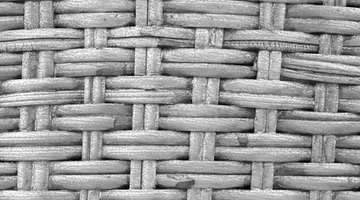How to Replace the Bottom of a Ladderback Chair
Ladderback chairs can have multiple options for replacement bottoms. One of the most popular options is a hexagonal patterned caned seat. The process can seem complicated in the beginning. It is important to remember that there are a total of six separate layers required to form the seat. New layers develop as caning strands are woven into the previous layer.

-
Find the required cane strands' size by measuring the distance between the chair bottom's existing holes and diameter of the hole. There are six sizes: common, narrow medium, fine, fine fine and superfine. A kit comes with enough strands to finish one chair. Kits can be purchased on line or a crafts supply store.
-
Discard remaining damaged or old cane on chair's seat frame. Remove all nails or staples used to fasten the old cane to then chair. Sand smooth any wood roughened by fasteners or old glue. Repair any cracked holes with glue. Let the glue dry for 24 hours before starting caning process.
-
Soak strands of cane in water for 20 minutes before using. The strands must be moist and pliable during the weaving process. Dampen them with a wet sponge occasionally. Cane naturally tightens as it dries.
-
Place the chair in an upright position and locate the center hole at the seat frame's back.
To begin the first layer, push a cane strand down the top of the hole. Leave 3 - 4 inches of the strand hanging below the frame. Secure the strand with a wooden peg at the top. Always secure each strand, when pulled from a top hole, with a peg. At the frame's front center hole, take the opposite end of the same strand and push it down. Gently pull it taut. Repeat until the seat bottom is completely covered with vertical rows from front to back. Remove the pegs.
When a strand comes to the end tie it to the length of strand hanging from the bottom. As each new strand is added leave same amount of length at the frame's bottom for future tie offs.A caning needle or needle nosed pliers can ease pulling the cane through the holes.
-
Weave second layer strands starting from the center hole of the right side of the seat frame to the top center hole of opposite left side. Keep the strands at a horizontal 90-degree angle to the first layer strands.
-
Create the third layer vertically through the same holes of the first layer. Weave strands up and over the second layer's horizontal strands.
-
Create the fourth layer by using the same holes of the second layer. Weave the vertical strands over the third layer strands and under the first layer strands.
-
Weave the fifth layer of cane strands from the top hole in the right-hand corner of the frame's back towards the top hole on the lower left corner. Weave each new strand up and over two existing vertical strands from layers one and three.
-
Weave the sixth layer of cane strands from the top hole in the left-hand corner of the frame's back towards the top hole on the lower right corner. Weave each new strand up and over two existing horizontal strands from layers two and four.
-
Finish the seat bottom by attaching binder cane strands. Measure the binding cane the same length as the sides the chair and add 3 - 4 inches. Place the binder strand flat where the seat's wooden edge meets the newly woven section. Pull a second strand of cane up through the hole from the frame's bottom and over the binder. Repeat around the same hole. Move to the next hole and repeat until binding is completely attached. Cut off protruding ends of binding with a utility knife or scissors.
References
Tips
- As more layers of cane have to be placed through the same hole, the awl can be gently rocked inside the holes to make more room.
- Cats love to sharpen their claws on cane bottomed seats. Dissuade them by wiping a bit of white vinegar along the caned bottom.
Writer Bio
Since 1993 Mona Harte's work has appeared in various publications, including "NYTimes Regional Newspaper Group," the "Calgary Sun," the "Great Falls Tribune" and the "Tahoe Daily Dispatch," as well as international magazines "Atlantica," "Portfolio," and "Open Skies." She holds an Associate of Arts in layout/design from the Art Institute of Pittsburgh.
Photo Credits
- woven image by Dwight Davis from Fotolia.com
More Articles



